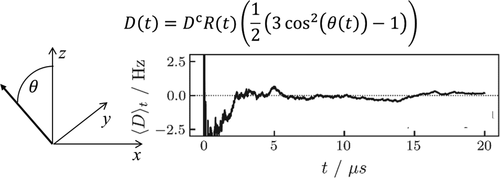当前位置:
X-MOL 学术
›
J. Phys. Chem. B
›
论文详情
Our official English website, www.x-mol.net, welcomes your
feedback! (Note: you will need to create a separate account there.)
A Method to Derive Structural Information on Molecules from Residual Dipolar Coupling NMR Data
The Journal of Physical Chemistry B ( IF 2.8 ) Pub Date : 2022-05-19 , DOI: 10.1021/acs.jpcb.2c02410 Wilfred F van Gunsteren 1 , Maria Pechlaner 1 , Lorna J Smith 2 , Bartosz Stankiewicz 3 , Niels Hansen 3
The Journal of Physical Chemistry B ( IF 2.8 ) Pub Date : 2022-05-19 , DOI: 10.1021/acs.jpcb.2c02410 Wilfred F van Gunsteren 1 , Maria Pechlaner 1 , Lorna J Smith 2 , Bartosz Stankiewicz 3 , Niels Hansen 3
Affiliation

|
A method for structure refinement of molecules based on residual dipolar coupling (RDC) data is proposed. It calculates RDC values using rotational and molecule-internal configurational sampling instead of the common refinement procedure that is based on the approximation of the nonuniform rotational distribution of the molecule by a single alignment tensor representing the average nonuniformity of this distribution. Using rotational sampling, as is occurring in the experiment leading to observable RDCs, the method stays close to the experiment. It avoids the use of an alignment tensor and thus the assumption that the overall rotation of the molecule is decoupled from its internal motions and that the molecule be rigid. Two simple molecules, two-united-atomic ethane and a cyclooctane molecule with eight side chains, containing 24 united atoms, serve as the so-called “toy model” test systems. The method demonstrates the influence of molecular flexibility and force-field deficiencies on the outcome of structure refinement based on RDCs. For a molecule of a given size (number of atoms Nat), there must be a sufficiently large number NRDC of measured RDC values available to allow the restraining forces to bias the overall orientation distribution of the molecule. If the ratio NRDC/Nat gets too small, the RDC-restraining forces will either not be strong enough to change the overall rotational direction of the molecule such that the target RDC values are approximated well or will be so strong that they induce a local deformation of the molecule. In the latter case, the size or inertia of the molecule hinders a restraining-induced overall rotation and the internal structure of the molecule is not strong enough to avoid local deformation due to the restraining forces.
中文翻译:

一种从剩余偶极耦合核磁共振数据中推导分子结构信息的方法
提出了一种基于残余偶极耦合(RDC)数据的分子结构细化方法。它使用旋转和分子内部配置采样来计算 RDC 值,而不是基于通过表示该分布的平均不均匀性的单个对齐张量来近似分子的非均匀旋转分布的常见细化过程。使用旋转采样,正如在导致可观察 RDC 的实验中发生的那样,该方法与实验保持接近。它避免了使用对齐张量,因此避免了分子的整体旋转与其内部运动分离并且分子是刚性的假设。两个简单的分子,两个联合原子的乙烷和一个具有八个侧链的环辛烷分子,包含 24 个联合原子,作为所谓的“玩具模型”测试系统。该方法证明了分子柔韧性和力场缺陷对基于 RDC 的结构细化结果的影响。对于给定大小的分子(原子数N at ),必须有足够多的N RDC测量 RDC 值可用,以允许约束力偏置分子的整体取向分布。如果N RDC / N at比值太小,则 RDC 约束力要么不足以改变分子的整体旋转方向,从而使目标 RDC 值非常接近,要么太强以至于它们会引起分子的局部变形。在后一种情况下,分子的大小或惯性阻碍了约束引起的整体旋转,并且分子的内部结构不足以避免由于约束力引起的局部变形。
更新日期:2022-05-19
中文翻译:

一种从剩余偶极耦合核磁共振数据中推导分子结构信息的方法
提出了一种基于残余偶极耦合(RDC)数据的分子结构细化方法。它使用旋转和分子内部配置采样来计算 RDC 值,而不是基于通过表示该分布的平均不均匀性的单个对齐张量来近似分子的非均匀旋转分布的常见细化过程。使用旋转采样,正如在导致可观察 RDC 的实验中发生的那样,该方法与实验保持接近。它避免了使用对齐张量,因此避免了分子的整体旋转与其内部运动分离并且分子是刚性的假设。两个简单的分子,两个联合原子的乙烷和一个具有八个侧链的环辛烷分子,包含 24 个联合原子,作为所谓的“玩具模型”测试系统。该方法证明了分子柔韧性和力场缺陷对基于 RDC 的结构细化结果的影响。对于给定大小的分子(原子数N at ),必须有足够多的N RDC测量 RDC 值可用,以允许约束力偏置分子的整体取向分布。如果N RDC / N at比值太小,则 RDC 约束力要么不足以改变分子的整体旋转方向,从而使目标 RDC 值非常接近,要么太强以至于它们会引起分子的局部变形。在后一种情况下,分子的大小或惯性阻碍了约束引起的整体旋转,并且分子的内部结构不足以避免由于约束力引起的局部变形。


















































 京公网安备 11010802027423号
京公网安备 11010802027423号